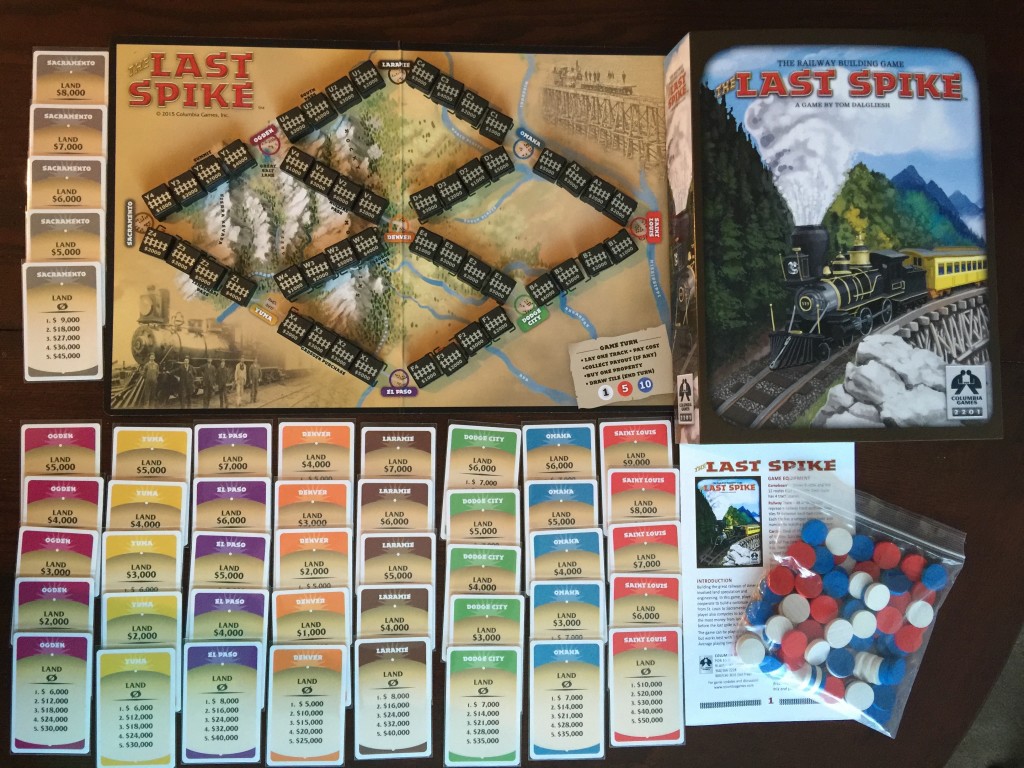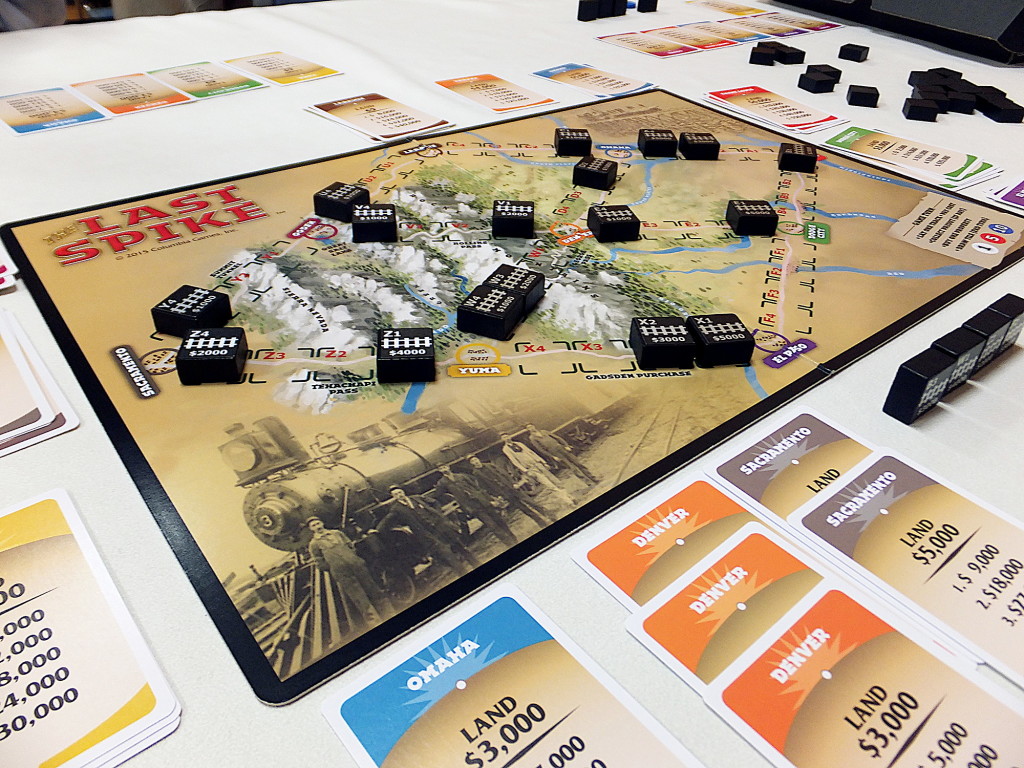I don’t know what it is about train games, but I have yet to meet one that I didn’t like. “Ticket to Ride“, “Sid Meier’s Railroads” on the PC…even “Continental Express“, as simplistic as it is, isn’t bad. “The Last Spike” is a bit more economical, tasking players with cooperating to build a continuous railway from St. Louis to Sacramento. Those who accumulate the most money by acquiring the right land cards at the right time in order to get big payouts, wins the game. I’d like to extend a quick thank-you to Grant Dalgliesh from Columbia Games for providing me with a free press copy for review purposes.
Components
The game includes one board (9 cities and the 12 routes that link them), 48 railway tracks (each with a unique letter/number code matching the spaces on the board), 45 land cards (5 for each of the 9 cities), and currency chips (white = $1000, red = $5000, blue = $10,000).
Setup & Gameplay
Firstly, each player gets a certain amount of money, depending on how many people are playing the game. The forty-eight railway tiles are placed face-down and mixed up, each player drawing one tile. The player closest to A1 goes first. The tiles are then put back, mixed up again, and each player draws four to form their hand (which is kept in secret). The land cards are put into separate stacks by city, the cards going in order from lowest on top (free land grant) to the most expensive on bottom. In a two player game, one tile is drawn from the mix unseen and removed from the game.
A player’s turn consists of the following:
1. Laying a track tile (mandatory) – The active player must lay one of their four track tiles onto the board, matching the letter/number code appropriately and paying the cost. A tile must be placed next to a city or any existing tile, otherwise the cost is doubled. If they cannot afford to place a tile, they must raise the cash by selling land (at half cost, rounding up). A payout occurs if two cities become connected with tiles. Every owner of either city receives a payout from the bank equal to the value listed on the matching city’s land card. The value will change, depending on how many cards you have of that city. Any player who lays the first track next to any city receives its free land grant card, though they may not purchase another land card that turn.
2. Buying land (optional) – The active player may buy any one land card assuming that the free grant card of the city in question has been claimed. The cost of the land card is listed on the top line.
3. Draw a tile from the pile.
Play continues until a path is formed from St. Louis to Sacramento. The player who laid down the last tile (or “last spike”) gets $20,000 and any payouts occur as normal. The players’ land cards are discarded and the player with the most money, wins the game!
Editor’s Note: The above doesn’t cover all of the rules found in the manual, but should give you an idea as to how the game is played.
The Review
“The Last Spike” is “Ticket to Ride” meets “Acquire”…at least, that was my first impression after playing my first game. It’s like “Ticket to Ride” in the sense that you’re laying down tracks between two cities, but it’s more like “Acquire” in the way the gameplay flows. Like “Acquire”, each track space on the board has a letter/number combination along with a matching tile that can be played by players on their turn. In addition, payouts can occur throughout adding a prediction element to gameplay. That is…will you decide to purchase cards in “X” city or “Y” city (or perhaps a little of both), in the hopes of seeing a payout? Not all cities will be lucrative as there are multiple paths from St. Louis to Sacramento (connecting them ends the game). “Acquire” is more complicated than “The Last Spike”, I feel, so no need to worry if you’re a casual gamer who is easily intimidated by economical games. This one is pretty light as economic games go.
Some people hate that I comment on the price in my reviews, though as a I consumer first, I feel my remarks to be extremely relevant based on my experience with buying and playing a TON of games. The going rate for “The Last Spike” is about $40 on the official website, higher than I would have pegged it to be. Games like “Dead of Winter” and “Stone Age” have fantastic components, for example, and both can be bought for around that price on Amazon. Here, you’re getting a lot of small wood tokens (either circular or square) along with some cards. Admittedly, the cards do like pretty nice in that they are colorful and easy to read. When you compare the number of components in this game with others like the aforementioned games though, then it leaves you to wonder why they have the same price. As I’ve been told countless times, some developers/publishers are able to buy in bulk (lowering the manufacturing price per unit) whereas Indie developers tend to not have the money for such investments. As a consumer though, you tend to not care about those things…rather, just what comes out of your wallet.
With that said, “The Last Spike” hits that certain sweet spot. For those of you who aren’t familiar with me, I tend to like games that are easy to learn but have a moderate amount of strategic depth. Turns in this game are incredibly simple and you’ll indeed spend more time thinking about what to do on your turn as opposed to what rules you have to follow. The fact that it is like “Acquire” but playing a bit more quickly is a bonus…sometimes I don’t want to devote sixty to ninety minutes in an economic game. “The Last Spike” lets you get your economic fix in half that time, making it a viable option on school nights. Everything about this game (price aside) is incredibly good and if you can afford to pick it up, then I’d recommend you do so.
Final Verdict: 8/10
—
Purchase: http://www.columbiagames.com/cgi-bin/query/cfg/zoom.cfg?product_id=2201
—


